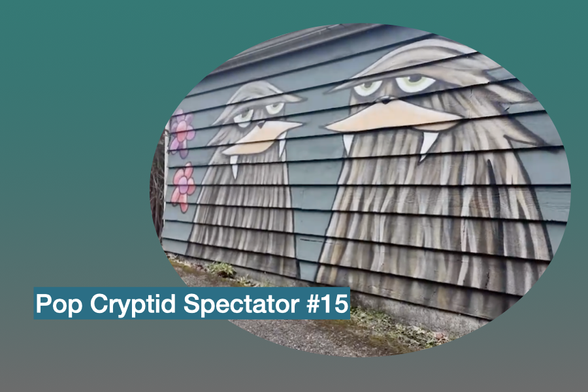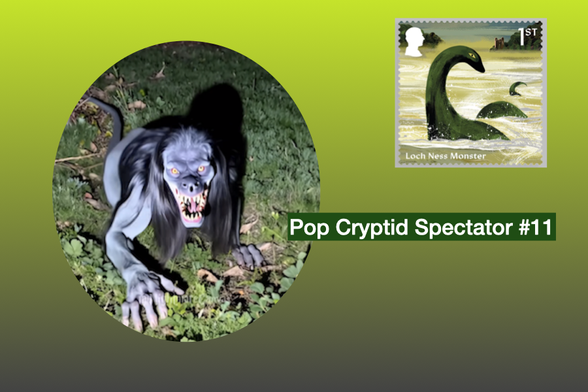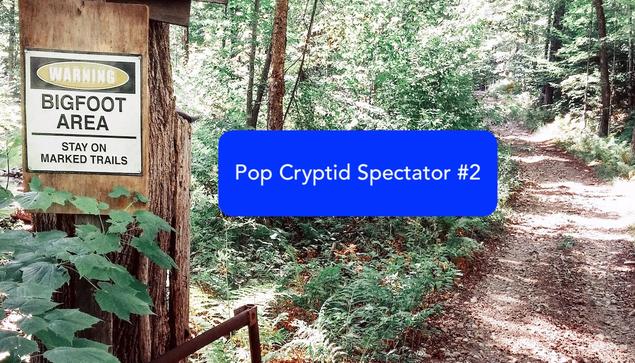Pop Cryptid Spectator 15
Hello and welcome to the 15 edition of Pop Cryptid Spectator – a newsletter solely meant to indulge my interest in the subject of cryptids in popular culture. If you’re reading it, that’s awesome; I appreciate it. It’s important to me to document changes in the thinking about mysterious animals over modern times. It’s not just some weird fringe subject, it’s mainstream now. The modern stories and events associated with mysterious animals reflect societal views and the different agendas of subgroups involved in the topic. This edition does go a bit heavy on the traditional view of cryptozoology, where people are interested in finding a real animal behind the rumors of existence. But, things will go off the rails, as everything has in this wacky 21st century. Thanks for joining me on this kooky trip.
In this edition:
- Florida Bigfoot Conference review
- Sasquatch heads around town
- AI cryptids: Faked Nessie sightings
- AI cryptids: Fake Yeti photo circulating
- AI Fake Coelacanth News
- Mokele-mbembe and Creationists’ corruption
- Cryptid media: The Cryptid Factor podcast
Florida Bigfoot Conference review
Amanda from Swell Entertainment attended the Great Florida Bigfoot Conference in Ocala a few weeks ago and posted a video review. I found several parts interesting but also, there was a lot of the same old thing that always happens with cryptid conferences (vs conventions which are more fan oriented). However, conferences usually suggest a more serious audience but cryptid events in general seem to be leaning more towards merchandise sales and para-celebrity attractions, with almost no scholarly presenters (maybe because there are so few).
For example, Amanda says there was considerable time given to the audience to supply content. That is, there was a panel discussion that was mostly audience questions, and there was a big session of testimonials where people were encouraged to tell their (sometimes long and rambling stories). Often, these events get one or two big name speakers from TV shows to draw fans. The quality of content is hit or miss.
Amanda didn’t have a strong background in Bigfoot information. This can be an advantage or disadvantage for a fair review. The advantage is that she had fresh eyes on the content and was unimpressed by the quality of much of the evidence presented, the over-reliance on eyewitness testimony, and poorly documented physical traces (like footprints). Additionally, she noted the drama that took place regarding a certain skunk ape researcher (if you know, you know – I know), who felt he should have been the main draw at this and previous events. Not only do these events not invite scholars (who are mostly going to be skeptics), they also have much ado about internal squabbles re: claiming areas, ideas, and even evidence, for themselves. All of this shows how “zoology” based cryptid research is unscientific. She even noted that very few presenters had a scientific background, and there was considerable fringe talk regarding conspiracies, government coverups, and even obvious nonsense about pseudoarchaeology and Roswell’s alien bodies. None of this is at all surprising.
From her comments, and from my past experience from such events, it seems that this event really leans into an agenda that transcends Bigfoot as simply a mystery to be solved. Going by the popularity of UAPs and eccentric ideas about nature, a portion of Bigfoot audiences will buy into scary concepts without foundation, where belief and personal testimony outweigh scientific evidence and critical evaluation. That’s not rational, that’s religion.
https://www.youtube.com/watch?v=mTiOZXToRk8
Sasquatch heads around town
Moving on to a more lighthearted, and very “pop cryptid” story, Seattle artist Henry is on a mission to paint 1000 Sasquatch faces across the city. He loves to create his cartoon, friendly-fanged version of the big guy and thinks it’s a nice way to connect the community with a common theme. He is still taking requests for locations on his website https://www.henry.art/1000-murals.html, if you have a spare space that needs a furry face.
AI cryptids: Faked Nessie sightings
I really didn’t anticipate that so many cryptid stories in the news would roll back around to AI. But with this slop taking over the internet and making that technology less useful every day, this is the way it’s going. The Loch Ness Centre has to consider that every photo they get purportedly of Nessie might be AI generated. In past decades, photo editing and hoaxes was a likely possibility, but now, the photos can be not only heavily manipulated through AI, but created entirely from prompts, not even needing some real event as a basis. The Centre has had to employ a team of consultants to examine the visual evidence for this kind of humbuggery.
Actually, the easier route is to not accept this kind of evidence at all. The odds are overwhelming that any image is not going to show anything worthwhile. Evidence needs to be far better than that.
AI cryptids: Fake Yeti photo circulating
For this story, I’m trying not to despair because the content is so blatantly fake that it should be obvious to anyone. But people still are circulating it as evidence of the Yeti. It’s so popular that Snopes.com had to put up a debunk of it. It began with an AI generated photo appearing on X (which I always call Xitter, pronounced “shi-ter”) showing a weird bear-like creature next to a man. It got over a million views. Within a few weeks, the image was being circulated on TikTok as evidence of the Yeti. This is not the first time that AI has been used to fool people with photo evidence of a hairy giant and other cryptids. The internet is making us stupid. I just hope most people see this as a form of modern art/commentary, and not real.
AI Fake Coelacanth News
And, finally, on the AI front, is the fake news circulated this week that a coelacanth (a cryptozoologist’s favorite red herring for mystery monsters that may still exist) was found off the coast of California. I wrote a separate post about this which you received if you are subscriber. It’s a depressing state of affairs when news media will simply regurgitate fiction as fact without checking. But this is a warning that it’s happening all the time and we need to be aware. Be SKEPTICAL! Check the sources.
Mokele-mbembe and Creationists’ corruption
In the past few PCS editions, I’ve mentioned the growing popularity of neodinosaurs (a term that was coined by Fortean and OG cryptozoology commentator Ivan Sanderson). In particular, the mokele-mbembe stories are showing up on media sites documenting the resurgence of belief by locals that a brontosaurus-like creature still exists in the Congo basin in Africa. A new piece from New Lines mag continues the story by emphasizing the connection of this tale to those trying to disprove evolution. The article packs a punch. I have to share a quote:
Mokele-mbembe is the Congo Basin’s bigfoot. Or that’s what it’s become, anyway — a cryptid. Nobody is sure when the myth originated, but it was born among the basin’s communities, who passed it down as an oral tradition. Locals tell me the myth was spiritual at first — a metaphor, perhaps, for humankind’s delicate relationship with the land. But today, nobody can say with certainty what exactly it meant because foreigners long ago twisted it well beyond recognition.
“Congolese people originally believed mokele-mbembe was a spiritual being, not a real dinosaur,” Oyange told me last year. “But that all changed when the white man came to Africa.” A confluence of European colonial expansion into Africa and the birth of paleontology gave rise to a version of mokele-mbembe that was a literal, flesh-and-blood, swamp-dwelling reptilian beast. Tales passed around by explorers, missionaries and colonial functionaries became warped by notions from Victorian literature and emerging science.
Take. Note. It is perfectly clear that the idea of a living dinosaur in the Congo was a manufactured myth. Unfortunately, it is still heavily promoted by a few backwards thinkers who insist that the Bible is a science book. And, worse than that, the locals now believe the modern myth. Similarly, the ideas of lake monsters and many other cryptids, especially Bigfoot, were linked to native stories by white people even where there was originally no strong similarity to the creature in the folklore. In time, the oral traditions merged with modern media depictions and the distinction between the two is lost, even to the point where modern Natives will equate their ancient tales to the manufactured media version of the creature. There have been several studies showing that when you go back to the original native tales of supernatural creatures, they do not resemble the exaggerated named cryptid of today. This article is worth a read.
Cryptid media: Cryptid Factor podcast
And now for something completely comedic. I have been listening to The Cryptid Factor when it was a radio show that turned into a podcast. I can’t remember the year I first heard it but I think it was 2008 or 2009. It was one of the earliest cryptid-related podcasts, though I use that term “cryptid-related” loosely. It’s more “cryptid-themed”. It wasn’t always easy to keep up. There were long breaks between episodes. For example, they are officially up to episode #106 in the 17 years that the show has been in existence. That’s 6.23 episodes per year. However, I forgive them because it’s hosted by TV and movie actor Rhys Darby, whom I first knew from one of my favorite shows, Flight of Conchords. Rhys is a busy guy, even appearing on the special X Files series event in 2016 as a cryptid himself. So the podcast crew couldn’t always manage a regular schedule. In the past 5 years, I gave up listening because I figured it was defunct. Instead, interest was surging on the pop cryptid wave! When I resubscribed a few months back, I realized that their fandom had expanded. Rhys and his cohosts now regularly promote the show, it’s on YouTube and they have a Shopify merch site! Clearly, hanging on to the brand through the lean times paid off. If you search for “cryptid” on BlueSky or Instagram social media feeds today, you’ll get Rhys as part of the results!
Like I said, the show is more comedic than anything. It’s all about having fun and being very silly. After all this time, I’m still not sure what the crew really believe or disbelieve but it doesn’t matter (since I have a liking for New Zealand accents). They have a genuine interest, but still not too much in depth knowledge, about cryptids and related subjects. I do credit Rhys for introducing me to the concept of the Taniwha (a mysterious creature of New Zealand that sort of serves as the catch-all monster, like the Bunyip of Australia). Even though the main purpose of the podcast appears to be an excuse for a trio of zany friends to make jokes and humorous sound effects, talk about their international travel, and “weekly” weird news stories, occasionally, some cryptid content is included. I love it. The Cryptid Factor was totally part of the Pop Cryptid scene before it even began!
Thanks for reading! Send comments, questions, or suggestions to sharon(at)sharonahill.com. If you want to send some cryptid plushies or other merch, or books to review, email for my physical mailing address.
For more, click on Pop goes the Cryptid landing page. Make sure you subscribe to all the posts – it’s always free and I don’t send annoying spam.
Pop Cryptid Spectator is also available on Substack. Please share this with cryptid fans you know!
Pop Cryptid Spectator Pop Cryptid Spectator 14Pop Cryptid Spectator 13
Pop Cryptid Spectator 12
Pop Cryptid Spectator 11
Pop Cryptid Spectator 10
Pop Cryptid Spectator 9
Pop Cryptid Spectator 8
Pop Cryptid Spectator 7
Pop Cryptid Spectator 6
Pop Cryptid Spectator 5
Pop Cryptid Spectator 4
Pop Cryptid Spectator 3
Pop Cryptid Spectator 2
#1 #2 #AICryptids #Bigfoot #BigfootHuntersDie #cryptid #cryptidFake #cryptidTVShow #giantOwls #GodzillaSighting #GoogleEarth #HoodCryptids #OutThereCrimesOfTheParanormal #popCryptids #scryptids #Skinwalker #TheCryptidFactor #Wendigo




